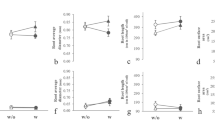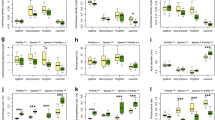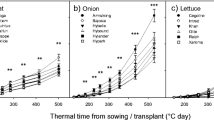Abstract
The well-known deceleration of nitrogen (N) cycling in the soil resulting from addition of large amounts of foliar condensed tannins may require increased fine-root growth in order to meet plant demands for N. We examined correlations between fine-root production, plant genetics, and leaf secondary compounds in Populus angustifolia, P. fremontii, and their hybrids. We measured fine-root (<2mm) production and leaf chemistry along an experimental genetic gradient where leaf litter tannin concentrations are genetically based and exert strong control on net N mineralization in the soil. Fine-root production was highly correlated with leaf tannins and individual tree genetic composition based upon genetic marker estimates, suggesting potential genetic control of compensatory root growth in response to accumulation of foliar secondary compounds in soils. We suggest, based on previous studies in our system and the current study, that genes for tannin production could link foliar chemistry and root growth, which may provide a powerful setting for external feedbacks between above- and belowground processes.



Similar content being viewed by others
References
Binkley D, Giardina C (1998) Why do trees species affect soils? The warp and woof of tree-soil interactions. Biogeochemistry 42:89–106
Bloom AJ, Chapin FS, Mooney HA (1986) Resource limitation in plants—an economic analogy. Annu Rev Ecol Syst 17:363–392
Burnham KP, Anderson DR (2002) Model selection and multimodel inference: a practical information-theoretic approach. Springer, Berlin Heidelberg New York
Cox G, Fischer DG, Hart SC, Whitham TG (2005) Non-response of native cottonwood trees to water additions during summer drought. West N Am Nat 65:175–185
Dawkins R (1982) The extended phenotype: the long reach of the gene. Oxford University Press, Oxford
Dickmann DI, Nguyen PV, Pregitzer KS (1996) Effects of irrigation and coppicing on above-ground growth, physiology, and fine-root dynamics of two field-grown hybrid poplar clones. Forest Ecol Manage 80:163–174
Driebe EM, Whitham TG (2000) Cottonwood hybridization affects tannin and nitrogen content of leaf litter and alters decomposition. Oecologia 123:99–107
Fischer DG, Hart SC, Whitham TG, Martinsen GD, Keim P (2004) Ecosystem implications of genetic variation in water-use of a dominant riparian tree. Oecologia 139:188–197
Friedman JM, Lee VJ (2002) Extreme floods, channel change, and riparian forests along ephemeral streams. Ecol Monogr 72:409–425
Hättenschwiler S, Vitousek PM (2000) The role of polyphenols in terrestrial ecosystem nutrient cycling. Trends Ecol Evol 15:238–243
Hendricks JJ, Nadelhoffer KJ, Aber JD (1993) Assessing the role of fine roots in carbon and nutrient cycling. Trends Ecol Evol 8:174–178
Hendricks JJ, Aber JD, Nadelhoffer KJ, Hallett RD (2000) Nitrogen controls on fine root substrate quality in temperate forest ecosystems. Ecosystems 3:57–69
Hendrickson OQ, Robinson JB (1984) Effects of roots and litter on mineralization processes in forest soil. Plant Soil 80:391–405
Hirsch AM, Bauer WD, Bird DM, Cullimore J, Tyler B, Yoder JI (2003) Molecular signals and receptors: controlling rhizosphere interactions between plants and other organisms. Ecology 84:858–868
Ibrahim L, Proe MF, Cameron AD (1998) Interactive effects of nitrogen and water availabilities on gas exchange and whole-plant carbon allocation in poplar. Tree Physiol 18:481–487
Johnson MG, Tingey DT, Phillips DL, Storm MJ (2001) Advancing fine root research with minirhizotrons. Environ Exp Bot 45:263–289
Joslin J, Wolfe MH (1999) Disturbances during minirhizotron installation can affect root observation data. Soil Sci Soc Am J 63:218–221
Keim P, Paige KN, Whitham TG, Lark KG (1989) Genetic analysis of an interspecific hybrid swarm of Populus: occurrence of unidirectional introgression. Genetics 123:557–565
Kraus TEC, Dahlgren RA, Zasoski RJ (2003) Tannins in nutrient dynamics of forest ecosystems—a review. Plant Soil 256:41–66
Kraus TEC, Zasoski RJ, Dahlgren RA, Horwath WR, Preston CM (2004) Carbon and nitrogen dynamics in a forest soil amended with purified tannins from different plant species. Soil Biol Biochem 36:309–321
Lee K, Jose S (2003) Soil respiration, fine root production, and microbial biomass in cottonwood and loblolly pine plantations along a nitrogen fertilization gradient. Forest Ecol Manage 185:263–273
LeRoy CJ, Whitham TG, Keim P, Marks JC (2006) Plant genes link forests and streams. Ecology 87:255–261
Litton CM, Ryan MG, Raich JW (2006) Carbon allocation in forest ecosystems. Oecologia (in review)
Madritch MD, Hunter MD (2002) Phenotypic diversity influences ecosystem functioning in an oak sandhills community. Ecology 83:2084–2090
Martinsen GD, Whitham TG, Turek RJ, Keim P (2001) Hybrid populations selectively filter gene introgression between species. Evolution 55:1325–1335
Means JE, Hansen HA, Koerper GJ, Alaback PB, Klopsch MW (1994) Software for computing plant biomass—BIOPAK users guide. Gen. Tech. Rep. PNW-GTR-340. US Department of Agriculture, Forest Service, Pacific Northwest Research Station, Portland, Oregon
Nadelhoffer KJ, Aber JD, Melillo JM (1985) Fine roots, net primary production, and soil nitrogen availability: a new hypothesis. Ecology 66:1377–1390
Northup RR, Dahlgren RA, McColl JG (1998) Polyphenols as regulators of plant-litter–soil interactions in northern California’s pygmy forest: a positive feedback? Biogeochemistry 42:189–220
Phillips D, Ferris AH, Cook DR, Strong DR (2003) Molecular control points in rhizosphere food webs. Ecology 84:816–826
Pregitzer KS, Friend AL (1996) The structure and function of Populus root systems. In: Stettler RF, Bradshaw HD Jr, Heilman PE, Hinckley TM (eds) Biology of Populus and its implications for management and conservation. NRC Research Press, Ottawa, pp 331–354
Pugesek BH, Tomer A, von Eye A (2003) Structural equation modeling: applications in ecological and evolutionary biology. Cambridge University Press, Cambridge
Rehill BJ, Clauss A, Wieczorek L, Whitham TG, Lindroth RL (2005) Foliar phenolic glycosides from Populus fremontii, Populus angustifolia, and their hybrids. Biochem Syst Ecol 33:125–131
Schweitzer JA (2002) Ecosystem consequences of genes: from Populus litter quality to nitrogen mineralization rates. PhD thesis, Northern Arizona University, Flagstaff
Schweitzer JA, Bailey JK, Rehill BJ, Martinsen GD, Hart SC, Lindroth RL, Keim P, Whitham TG (2004) Genetically based trait in a dominant tree affects ecosystem processes. Ecol Lett 7:127–134
Schweitzer JA, Bailey JK, Hart SC, Wimp GM, Chapman SK, Whitham TG (2005) The interaction of plant genotype and herbivory decelerate leaf litter decomposition and alter nutrient dynamics. Oikos 110:133–145
Sterner RW, Elser JJ (2002) Ecological stoichiometry: the biology of elements from molecules to the biosphere. Princeton University Press, Princeton
Treseder KK, Vitousek PM (2001) Potential ecosystem-level effects of genetic variation among populations of Metrosideros polymorpha from a soil fertility gradient in Hawaii. Oecologia 126:266–275
Whitham TG, Young WP, Martinsen GD, Gehring CA, Schweitzer JA, Shuster SM, Wimp GM, Fischer DG, Bailey JK, Lindroth RL, Woolbright S, Kuske CR (2003) Community and ecosystem genetics: a consequence of the extended phenotype. Ecology 84:559–573
Whitham TG, Lonsdorf E, Schweitzer JA, Bailey JK, Fischer DG, Shuster SM, Lindroth RL, Hart SC, Allan GJ, Gehring CA, Keim P, Potts BM, Marks J, Rehill BJ, DiFazio SP, LeRoy CJ, Wimp GM, Woolbright S (2005) “All effects of a gene on the world”: extended phenotypes, feedbacks, and multi-level selection. Ecoscience 12:5–7
Wimp GM, Martinsen GD, Floate KD, Bangert RK, Whitham TG (2005) Plant genetic determinants of arthropod community structure and diversity. Evolution 59:61–69
Acknowledgements
We thank the Ogden Nature Center and NSF IRCEB and FIBR grants for infrastructure and financial support, respectively. Brett Dickson consulted on use of model selection theory. We also thank Nathan Lojewski, Pam Cox, Piper Townsend, Greg Cox, Jen Schweitzer, Carri LeRoy, Gina Wimp, Julius Cantella, Paul Selmants and the Hart, Lindroth, and Whitham laboratories for field assistance and providing comments on earlier versions of the manuscript. We also thank Drs. Amy Austin, Phyllis Coley, and two anonymous reviewers for providing helpful reviews of this manuscript.
Author information
Authors and Affiliations
Corresponding author
Additional information
Communicated by Phyllis Coley
Rights and permissions
About this article
Cite this article
Fischer, D.G., Hart, S.C., Rehill, B.J. et al. Do high-tannin leaves require more roots?. Oecologia 149, 668–675 (2006). https://doi.org/10.1007/s00442-006-0471-7
Received:
Accepted:
Published:
Issue Date:
DOI: https://doi.org/10.1007/s00442-006-0471-7




